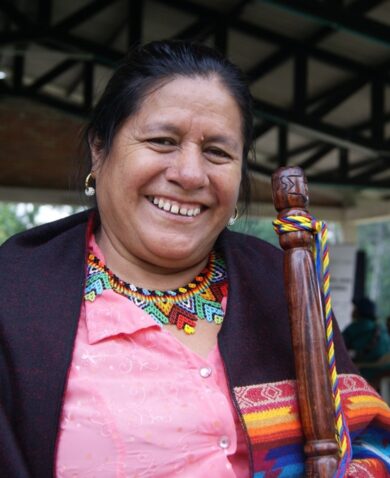
Working the System: What We’ve Learned About Strengthening Accountability
December 20, 2018 | 4 Minute ReadWhat is the most effective way to strengthen accountability in our development work? Sarah Nugent shares a promising approach that enables civil society to circumvent political barriers and create power: clusters.
When designing a new project, how often do we set out to strengthen a particular actor’s or institution’s ability to “hold government to account?” What does that mean exactly? Maybe the better question to ask is: what is the most effective way to strengthen accountability in our development work? And then, what does it look like in practice? Strengthening government accountability, or holding authorities responsible for their actions, is a challenging problem in any technical sector. Whether we are striving for fair elections, acceptable health services, inclusive education policy, or transparent use of tax revenue, government accountability looks different in every country and political context. It’s a tough nut to crack.
At Chemonics, we have been thinking a lot about how to answer both of these questions within the framework of accountability ecosystems. Recently, professionals from Chemonics, the International Budget Partnership, and Root Change came together in a one-day learning session to further explore their understanding of accountability ecosystems approaches in theory and practical experience from the USAID Strengthening Advocacy and Civic Engagement (SACE) project in Nigeria. A second event, at OpenGovHub, invited public discussion and further exchange of ideas.
Over the past several years, there has been an evolution of thinking in the development community around strengthening governance and public service delivery. The practice is moving from a linear pathway (transparency + participation = accountability) to a more holistic approach, which recognizes that change takes place within a complex system of actors, institutions, and power, known as the accountability ecosystem. The approach has five underlying elements:
- Mapping and analysis of the ecosystem
- Vertical and horizontal integration
- Strategic use of varied and complementary tactics
- Learning and adaptation
- Thinking and working politically
The accountability ecosystem approach embraces thinking and working politically — digging below the surface of a political system to understand the underlying incentives, relationships, and power dynamics between actors and institutions — to tailor interventions that can shape government responsiveness in a specific geography and political context.
The Clout of Clusters: Lessons Learned from Nigeria
The SACE project brought an innovative approach to supporting civil society effectiveness to strengthen accountability in a challenging national context. The project’s objective was to strengthen Nigerian civil society’s ability to influence the development and implementation of key democratic reforms at the national, state, and local levels.
Framed by accountability ecosystem principles, SACE’s theory of change embraced the idea that more successful civil society campaigns connect the dots between multiple levels of government, a diverse coalition of allies and opponents, and complementary tools and tactics to circumvent organizational and political barriers and create power. In SACE’s case, this enabled civil society to strengthen accountability and governance in several ways, including inclusive education for people with disabilities, open and transparent budgeting related to revenue from extractives, and increased budget expenditures for youth. To achieve this, the project created “clusters” of civil society organizations (CSOs) committed to working together towards a common policy objective. A backbone “anchor” organization managed the collaboration and coordination for all members of the issue cluster. Together with the SACE project team, the cluster CSOs co-created the policy objective and a coordinated strategy with mutually supportive, politically savvy activities.

The public event shared the experience generated by SACE and its partner organizations and opened up the discussion with the larger development community. Participants came away from the event with four takeaways:
- Rather than focusing on management-centered capacity development approaches, SACE’s implementation strategy focused on building next generation practices that concentrated on strong ecosystem level engagement, which developed the social capital between the organizations in the cluster. By bringing the CSOs’ complementary expertise together, a cluster could achieve greater collective impact than individual CSOs could have on their own.
- Building in dedicated time for learning, reflection, and adaptation was key to SACE’s achievements. Adaptive management allowed SACE to work in a complex and ever-changing place like Nigeria and remain agile in order to see incremental reform.
- SACE developed simple, yet effective tools and transferred those to the CSO clusters. An outcome harvester using post-it notes, an Excel-based policy matrix, and What’s App communication groups are simple tools that were easily replicated — even by organizations with limited means — to develop adaptive management systems and processes.
- Programmatic flexibility goes hand-in-hand with operational and donor flexibility. Following a prescribed, linear process would not have achieved the results SACE produced. When changes happened in the local context (e.g., newly elected officials, new government policies), it required a willingness for the CSO cluster groups to make modifications to objectives, strategies, or tactics and to try something new or recover after a setback. It also required the SACE team and USAID to be willing to tolerate such changes and the uncertainties that accompanied them.
Practical evidence from projects, like SACE, that operate in complex political environments has added to the body of evidence that will help implementors better understand the realities of strengthening accountability and what outcomes can be achieved as a result. We look forward to sharing more learning and practical experience to further bridge the gap between theory and practice. If you have project experience to share, let’s hear from you.
Posts on the Chemonics blog represent the views of the authors and do not necessarily represent the views of Chemonics.








































